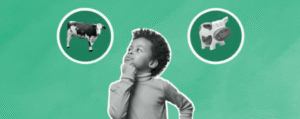an·thro·po·mor·phism the attribution of human characteristics or behavior to a god, animal, or object.
The term anthropomorphism traces its origins to the Greek philosopher Xenophanes, who used it to critique humanity’s inclination to impose human characteristics upon their deities. These gods, though revered as omnipotent and eternal, were often depicted as susceptible to very mortal emotions—joy, fury, envy—as if divinity itself were bound by the frailties of human nature. Their wrath could topple empires, just as their favor could raise new ones from ruin. Yet even these incomprehensible beings were not spared the anthropocentric gaze through which we perceive all existence. This reveals a fundamental truth: we are innately driven to find reflections of ourselves—not only in gods but in animals, objects, and the world beyond.
From the way we clothe our pets to the moving and talking fruits on children’s television shows, anthropomorphism is everywhere. We name our plants, cars, hurricanes and sometimes go so far as to assign certain personalities to them.
However, anthropomorphism goes well beyond the identification of human characteristics. It also strongly influences the way we treat these anthropomorphized objects and animals [1]. In The Giving Tree, the tree’s boundless generosity and unconditional love for a man who continually takes from it evokes a profound sense of melancholy and compassion in the reader. Similarly, when a dog whimpers in a way we perceive as pain, it triggers an immediate emotional response—urging us to intervene and alleviate its suffering. In both cases, anthropomorphism bridges the gap between human emotions and non-human experiences, deepening our empathy and compelling us to act.

Illustration by Zian Bonoan
Ways Anthropomorphism Can Influence Animal Welfare
“Perhaps the most important implication of anthropomorphism is that perceiving an agent to be human renders it worthy of moral care and consideration”
If anthropomorphism can foster empathy toward non-human animals, then perhaps it is a valuable tool in normalizing their ethical treatment—particularly in industries and environments where they are often overlooked.
A compelling example comes from a study by Schobin et al., which examined how anthropomorphism influences food choices. University students were presented with menus featuring either anthropomorphized or non-anthropomorphized images of the main ingredient in each dish. The goal was to test a non-intrusive intervention—one that didn’t restrict choice but subtly encouraged more sustainable decisions. The results revealed that students were significantly less likely to select beef or chicken dishes when the images were anthropomorphized.
This demonstrates how anthropomorphism can be strategically employed to cultivate moral consideration for animals, encouraging behaviors that align with their welfare. In contexts where animals are routinely commodified, such techniques could help reshape perceptions and promote more compassionate decision-making.
How can Anthropomorphism be harmful?
While anthropomorphism can foster empathy toward animals, there is growing concern that it may ultimately cause more harm than good. A significant risk lies in the misinterpretation of animal behavior, where well-intentioned but misguided assumptions lead to improper care and handling. As noted by Mota-Rojas et al., our tendency to project human emotions onto animals can obscure their true needs, motivations, and natural behaviors. For instance, despite dogs’ innate ability to thermoregulate, many owners insist on clothing them—a practice that can result in overheating, heatstroke, or even fatal consequences.
Beyond physical harm, anthropomorphism also distorts perceptions of animal behavior, particularly in children who are still forming their understanding of the natural world. Children’s media often depicts animals with exaggerated human traits, reinforcing unrealistic expectations. A study by Patricia Ganea et al. examined the impact of anthropomorphized storybooks on young learners and found that five-year-olds exposed to such depictions were less likely to retain factual information about real animals. Moreover, these children were more inclined to attribute human characteristics to animals, blurring the line between fantasy and biological reality.
This suggests that while anthropomorphism may strengthen emotional bonds, it risks undermining both animal welfare and accurate ecological awareness—especially in impressionable audiences.
In conclusion
Anthropomorphism—the attribution of human characteristics to non-human entities—can foster empathy and moral consideration toward animals, enhancing their perceived worth. However, when taken too far, it risks distorting our understanding of their true nature. Misinterpreting animal behavior through an overly human-centric lens may lead to neglect of their species-specific needs, ultimately resulting in misguided and potentially harmful care.
Illustration by Zian Bonoan
References:
- Servais, V. (2018, December 18). Anthropomorphism in Human–Animal Interactions: A Pragmatist View. Frontiers in Psychology SA. https://doi.org/10.3389/fpsyg.2018.02590
- Waytz, A., Epley, N., & Cacioppo, J. (2010, February). Social Cognition Unbound: Insights Into Anthropomorphism and Dehumanization. Curr Dir Psychol Sci. https://doi.org/10.1177/0963721409359302
- Schobin, J., Haefner, G., & Leon, A. K. (2022, March 10). Frying nemo? Experimental evidence on anthropomorphism, animal ethics, and food choice. Elsevier. https://doi.org/10.1016/j.appet.2022.105989
- Mota-Rojas, D., Mariti, C., Zdeinert, A., Riggio, G., Mora-Medina, P., del Mar Reyes, A., Gazzano, A., Domínguez-Oliva, A., Lezama-García, K., José-Pérez, N., & Hernández-Ávalos, I. (2021, November 15). Anthropomorphism and Its Adverse Effects on the Distress and Welfare of Companion Animals. Animals, 11(11), 3263. https://doi.org/10.3390/ani11113263
